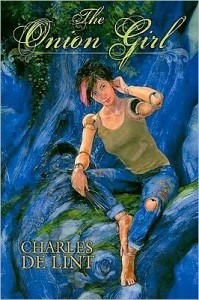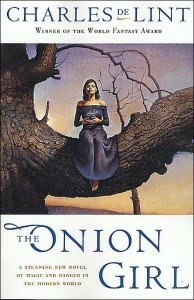Anyone who’s ever visited Charles de Lint’s mythical North American city of Newford knows Jilly Coppercorn. Artist, visionary, friend, described by de Lint as “the heart and soul of Newford.” She moves from story to story, book to book, the sort of person who knows and is known by just about everyone. From her first cameo appearance in the short story “Uncle Dobbin’s Parrot Fair” (reprinted in de Lint’s short story collection Dreams Underfoot), all the way to his most recent book, she’s been a constant intertwining thread, a shining beacon of belief and friendship. For she sees magic, and believes, and in doing so, makes it just a little more real for the rest of us. For years, she’s existed on the periphery of the stories, aiding and advising her friends, often acting as a witness to events the rest of us would never believe in. Thus far, we’ve only been allowed the occasional glimpse into the danger-fraught life that made her the woman we know, as in the story “In The House Of My Enemy” (originally published in Dreams Underfoot, reprinted in The Armless Maiden and Other Tales for Childhood’s Survivors, edited by Terri Windling). Until now, we’ve never been close enough to truly know her, for all that she is known. But at long last, Jilly Coppercorn’s starring in her own story.
THE BROKEN GIRL
It all changes in the blink of an eye, on a tragic night in April. The flash of headlights. The screech of tires. The sound of flesh and metal. Jilly Coppercorn wakes up in the hospital, the victim of a hit-and-run accident that’s left her partially paralyzed, badly wounded, unable to move or draw as once she did. Her friends rally around her, and for the first time, it’s made evident just how many of the characters in the Newford stories consider her a friend.
Sophie Etoile, the fae-blooded daughter of the moon, who spends half her life in the dream city of Mabon. Wendy St Clair, who once grew a Tree of Tales from a magical acorn. Christy Riddell, the modern-day collector of urban fairy tales, and his girlfriend Saskia, incarnation of the Wordwood. Professor Dapple, whose manservant Goon is a goblin. Geordie Riddell, Newford’s favorite busker, who once lost a woman to an accident of time. Angela Marceau, the Angel of Grassi Street. Lou Fucceri, the policeman who helped Jilly off the streets and into a new life. Cerin and Meran Kelledy, fae spirits from the past. Joe Crazy Dog, the visionary with a coyote’s spirit, and his own girlfriend, Cassie. Mona, a cartoonist who’s had her own supernatural experiences.
If this sounds like the all-star reunion of Charles de Lint’s vast and fascinating repertoire of characters, that’s because it, quite simply, is. No one’s touched as many lives or stories as Jilly Coppercorn, and thus, when the brightest among them is struck down, they all come to her side.
And she’ll need all the help she can get. For while her body lies broken and discouraged in this world, Jilly’s spirit soars as she sleeps in the otherworld of Mabon and elsewhere. Before she can begin to truly heal, she’s going to have to face her past, and deal with some heavy baggage. We’ve seen before that her life wasn’t a happy or pleasant one, until she reinvented herself as Jilly Coppercorn. But before she was Jilly, she was someone else altogether, and it’s that person’s life with which she must now come to terms.
THE DESERTED SISTER
Jilly’s not the only one with a story to be told. For after she left home, to begin her journey into the woman she is today, she left behind a family, a dangerous and ill-starred clan of white trash. Abusive brother. Alcoholic mother. Neglectful father. And worst of all, a younger sister suddenly deprived of the only person she could look up to. A sister, Raylene, who has to grow up the hard way, becoming hard and clever and fast with a knife, taking her due from the world when it won’t give her a break. When she and her friend Pinky leave home for the last time, it’s to undergo their own growth and trial by fire. Until the day, decades later, when paths cross, and it’s time for family to once again reunite. Only Raylene’s bitterness could destroy Jilly and all she cares for.
THE WORLD AS IT IS/MABON
The story continues to flip-flop between the worlds, between the Broken Girl of the World As It Is and the unhurt Jilly Coppercorn of the otherworld. Her friends on both sides of the barrier must continue to aid her, to grant her strength, and to protect her against the threat gradually closing in. We meet again the Crow Girls, Mister Truepenny, Jeck, Whiskey Jack, and some all-new characters and places of the otherworld. Jilly’s journey of self-discovery will force her to look deep into her heart and history before it’s over.
CHILDREN OF THE SECRET
When all’s said and done, the characters of Newford will have changed, and grown. Nothing is easy, magic demands a price, and blood will be shed. This will be a test for all of them: for Wendy and Sophie, for Joe and Cassie, for Maylene and Pinky, and most of all, for Jilly. This is the story of the Onion Girl, so called for she is made of layers, and every time you strip one away, another is revealed, and what’s at the core will make all the difference.
In many ways, this could easily be regarded as the capstone to the Newford stories, the final act of the play, the last chapter of the book. De Lint has stated that he put off writing Jilly’s story for years because it would have felt too much like closure. And in that, he’s right. The Onion Girl takes all those other Newford stories, references them, weaves them together, and proudly unfurls the grand tapestry that they all make. By bringing together all these characters, and showing how they all relate, both to each other and through Jilly, de Lint has told perhaps the best Newford story to date. If he never wrote another one, this would stand as the culmination of dozens of stories and years of writing. In that regard, this is closure, for of all the characters, Jilly was the one without a story, without an ending, and in the most need.
But it’s just the end of the first act. The close of the first book in the series. As the author says, “…closure doesn’t necessarily mean the end of a thing. It can also be a beginning.” The beginning of new stories. New friendships. New loves. New paths. New books. Because you can always plant an onion and from it grow more. And that’s what Charles de Lint has done with The Onion Girl. He’s pulled away all these layers of story and background and relationships, until what’s left is Jilly herself, the center of the onion, and now he can plant the seeds for the next onion’s worth of Newford. Whether Jilly will continue to play as large a part is anyone’s guess. But one thing is for certain, and that is that Newford’s stories are nowhere near played out.
If I haven’t made it clear yet, this isn’t just his best work to date, it’s his most satisfying, filled with tragedy and magic, reminding us that while we are what the world makes of us, we’re also what we make of ourselves. It’s about hope, love, family, growth, change, journeying, and redemption. It’s about being the light in the darkness, and never letting that light go out. It’s about being alive, and being free, and how living with friends means you’re not living in a vacuum. What happens to Jilly affects the far-flung cast of characters just as much as it does her. This is de Lint at his finest, blending the real and magical seamlessly, so that it’s impossible to tell where one leaves off and the other begins, and making it clear that the true magic always starts within us.
Part of The Onion Girl was originally seen as the short story “In The House Of My Enemy”, which has been added in full because, as de Lint says, “I didn’t have the heart to recast the events for this book simply to say it in new words. Jilly goes through enough already with what happens to her in this novel.”
For fans of the author, this is a must read. For those who love urban fantasy, magical realism, fantasy with a trace of spiritualism, or just a good read, this is a don’t miss. And for those who have ever suffered through some of life’s crueler slings and barbs, it’s a message that happy endings can and do still exist, even when it’s a near-impossible task to overcome the obstacles. Don’t just get this book for yourself; share it with those who need the reassurance. Magical cures are no substitute for the process of surviving and overcoming the hardships of the world and still remembering how to live, but believing in magic can sometimes make all the difference.
And last-minute kudos to Green Man’s own Cat Eldridge, who receives an acknowledgement from de Lint for the packets of music he sent during the writing of this book. You know who to blame, folks.


